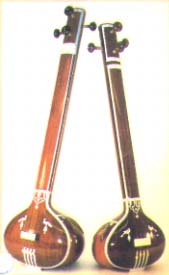Tanpura

A fretless instrument originally from central Asia, the tanpura is mentioned in references dating back to the sixteenth and seventeenth centuries. It was Indianized and served as a drone Instrument once the bridge had been modified and the instrument itself made larger. As a drone instrument, it repeats the tonic (the main note) and is an accompanying instrument in the classical music genre.
Structurally, the tanpura is comprised of a hemispherical base called the tumba - carved out of a dried gourd and functioning as a resonance chamber; the tabli or resonating plate that covers the open part of the tumba; the stem - dand - with the fingerboard on its front surface; and connecting the tumba and the dand is the gulu or neck. The main tuning pegs are placed on the top end - one on either side and two at the forefront. The size itself can vary from player to player, and the tanpura instruments can be classified as male or female instruments based on the tone and size. The strings are suspended over two bridges: The top one called meru or ara, and the lower bridge known as ghodi or ghodaj. The ghodi bridge allows the strings through at an angle, and this is responsible for the peculiar buzzing sound known as jawari. Another distinct feature is the silk (or cotton) thread pieces that cushion the strings, thereby enhancing the quality of sound.
Of the four metal strings, three are tuned to the higher pitch and the fourth to the low pitch. The tuning is set to several notes, predominantly the prime notes. The notes and their tuning combinations lead to the creation of the gandhara (Ga) note that no string has been tuned to. This self-emanated sound is thus referred to as Swaymbhu (self-created). It is heard fleetingly, but is the litmus test for correct tuning.
The middle and index fingers of the right hand are used to pluck at the strings and herein, a definite pattern is followed so as to achieve the ideal drone sound. Because of the structure of the tanpura, notes - of the high and low pitches - tend to linger, tremendous overtones are produced, resulting in a complexity of sound that may well seem incongrous in a drone instrument.
